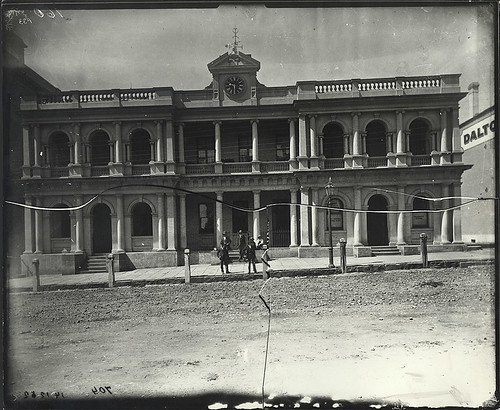Glass is generally more stable from a conservation viewpoint than film when used as the support or medium for a negative (despite the brittleness of glass). So I was interested to read Sandy Barrie’s essay ‘Why no Negs or records survive?’ in his book Australians Behind the Camera: directory of early Australian photographers 1841 to 1945 (The author, 2002).
Barrie’s work continues the listing of Australian photographers begun by Allan Davies, Peter Stanbury and Con Tanre in The Mechanical Eye in Australia : photography 1841-1900 (Oxford Uni Press, 1985).
This image was scanned from the original glass negative taken by Ralph Snowball. It is part of the Norm Barney Photographic Collection, held by Cultural Collections at the University of Newcastle, NSW, Australia.(Note the silvering around the edges of the negative as the emulsion deteriorates.)
Survival of the fittest?
As a practising photographer who worked in major studios, Barrie offers some insights into why negatives did not always survive.
- Commercial photographers were a business. Anything that would not generate continuing profit over time was a liability. Images that had long term commercial value were portraits of prominent people, landscapes and in Barrie’s words ‘newsworthy shots’. As historians the images that we search for may either have not been taken in the first place or if they were taken, were not judged as valuable enough to retain for the long term.
- There is the volume of negatives produced by studios. Barrie notes that the Tuttle Studios of Sydney took 30,000 portraits in 1897 alone. To add perspective to this statistic there were 57 photographers operating in the Sydney area in 1897 according to the Trade section of the Sands Directory.
- There is the large amount of space needed to store negatives, particularly if you were renting prime city real estate.
- Glass is heavy. As Barrie states ‘when you shoot several thousand negs a year, that adds up to a large Tonnage. There were even some notes in the early RPS journal of studio buildings collapsing under the weight, when photographers stored negs in their attics.'(p234) This led some photographers to store their negatives under their premises. For example if it is estimated that each 8″x10″ glass negative weighed 0.3kg, the output of Tuttle Studios for 1897 (see above) would weigh approximately 9,000 kg.
- Negatives could be cleaned of their image and recycled into two products that had value – the glass itself and the silver emulsion used to create the image. Companies would buy back negatives from commercial photographers to recover the silver. Photographic silver was rare during World Wars I and II and almost all silver was reserved for defence purposes in the latter. The Great Depression also saw large scale cleansing of glass negatives as commercial photographic sales fell and photographers needed income. Mr Barrie has told us that towards the end of World War II, Kodak had no means of making film base for cellulose negatives in Australia and many commercial photographers actually went back to using glass negatives.

Despite the breakage it has suffered this 1885 Bischoff image still retains its informational value.
I have always valued the images that survived. Now I will also value the glass negatives’ bulk and weight as a testament to that survival.
Help Sandy Barrie with his Research
Sandy Barrie can be contacted on apbarrie@dodo.com.au and is keen to hear from the relatives of Australian photographers. He is preparing a new edition of his book, which thanks to the National Library of Australia’s Trove will contain almost three times the data despite the impact on his research of the January 2011 Queensland floods.
Jenny Sloggett is an Archivist working in the Archives Control and Management section of State Records NSW.


pellethepoet says:
Great to hear Sandy is preparing a new edition of his book. His original book is keenly sought after by many, particularly the growing hordes of family historians, and is as rare as hen’s teeth! I for one have never found a copy. ‘The Mechanical Eye’ is another scarce one (last year a customer bought a copy from under my nose!) Two books that have been on the top of my wish list for many years.
Jenny says:
Thank you pellethepoet for your comment. We are privileged to have copies of both books in our library here at State Records Western Sydney Reading Room, looked after by our esteemed librarian Liz. Mechanical Eye is not just useful for me in dating family photographs (yes I am one of the swarm of family historians), but it is also a beautifully produced book. Jenny